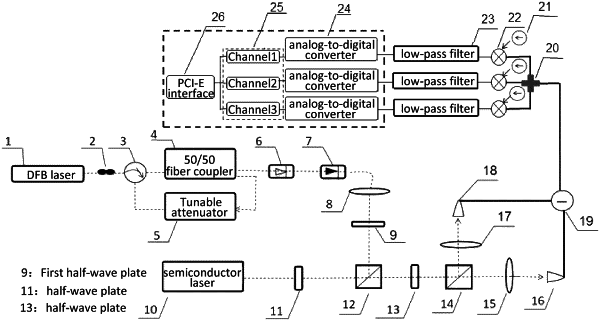| CPC H04L 9/001 (2013.01) [G06F 7/58 (2013.01); H04B 10/70 (2013.01); H04L 9/0852 (2013.01); H04L 9/0869 (2013.01)] | 5 Claims |

|
1. A method of real-time parallel quantum random number generation based on chaos amplifying quantum noise, comprising the following steps:
step 1: generating a chaotic laser beam based on an external cavity feedback laser, wherein a laser beam emitted by a DFB laser (1) sequentially passes through a polarization controller (2), a circulator (3), and a 50/50 fiber coupler (4), the 50/50 fiber coupler (4) splits the laser beam into two beams, one beam is fed back into a laser cavity through the tunable attenuator (5), and the other beam passes through an optical isolator (6) and a fiber filter (7) to form a chaotic laser beam, and the chaotic laser beam is transformed into a spatial light beam through a first fiber collimator (8), which then enters a first optical polarization beam splitter (12) through a first half-wave plate (9);
step 2: establishing a balanced homodyne detection system, and extracting quadrature fluctuations of a sideband quantum mode of the chaotic laser beam as the entropy source for generating quantum random numbers, wherein a single-mode continuous-wave laser beam emitted by a semiconductor laser (10) passes through a series of optical devices and is coherently coupled with the laser beam emitted by the DFB laser (1) at a second optical polarization beam splitter (14), and the laser beam from the semiconductor laser serves as local oscillator for balanced homodyne detection; and extracting quadrature fluctuations of several sideband modes of the quantum state of the chaotic laser beam as sub-entropy-sources for generating quantum random numbers, wherein two photocurrent signals converted by two photodetectors in a balanced photodetector are subtracted by a subtractor (19), the resulting signal is divided into several parts by a power divider (20) for output, radio frequency signals generated by radio frequency signal generators (21) and the photocurrent signals generated by the power divider are frequency-mixed at respective frequency mixer (22), signals output by the frequency mixer (22) are filtered by respective low-pass filters (23), in each path, filtered photocurrent signal is converted into digital signal by respective analog-to-digital converter (24) to obtain raw random numbers from the entropy sub-sources; wherein there are no radio frequency amplifiers connected to the power divider (20); and
step 3: based on the parallel computing feature of the field programmable gate arrays (FPGA), creating a universal Hash extractor for raw random numbers from each entropy sub-source in a single FPGA to extract quantum random numbers in parallel, wherein based on the parallel processing feature of the FPGAs (25), a large matrix operation is split into several small matrix operations, and a buffer is used at an outer layer to drive clock signals of each module, so as to design a two-layer parallel pipeline algorithm on the basis of coordinating logical resources and clock signals, wherein clocks for the analog-to-digital converter (24) and clocks for the parallel post-processing in real time in the FPGA (25) are uniformly controlled by a built-in clock; and random numbers output by these channels are mixed alternately per 16 bits, and results are transmitted to a computer through a PCI-E interface (26) in real time, to realized real-time quantum random numbers generation based on chaos amplifying quantum noise;
wherein the two-layer parallel pipeline algorithm comprises modules at three levels: a Toeplitz sub-matrix generation module at level 1 is configured to construct a Toeplitz sub-matrix in each clock cycle, and use a shift feedback register to update the Toeplitz sub-matrix in each clock cycle; a Toeplitz sub-matrix operation module at level 2 performs computation for a single sub-matrix; and a vector register exclusive-OR module at level 3 obtains a processing result of the single sub-matrix and stores the result in a register.
|